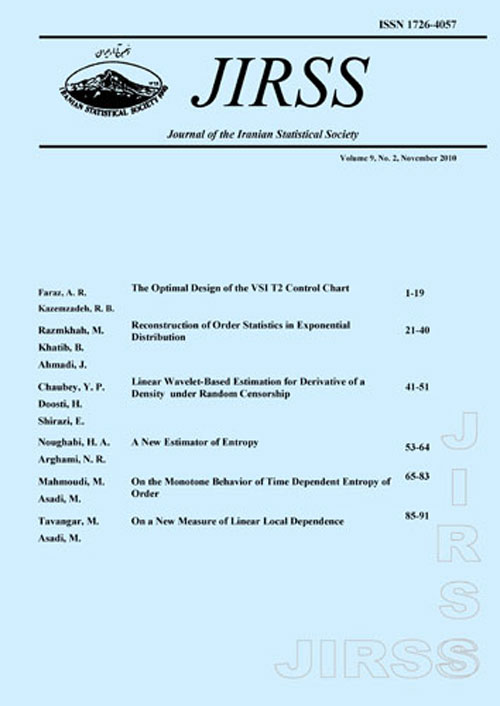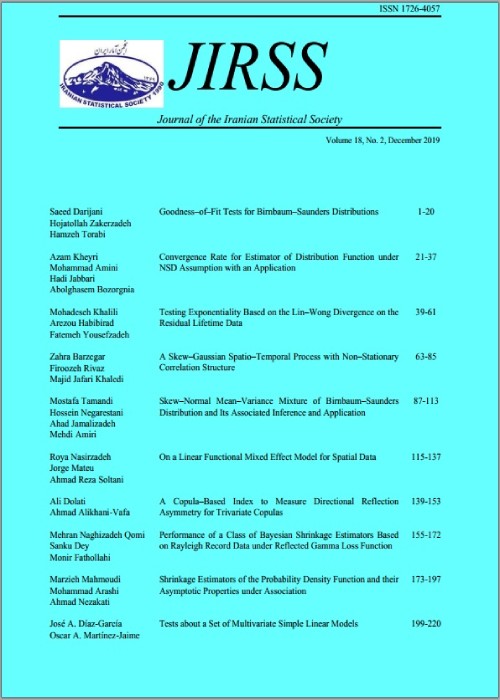فهرست مطالب

Journal of Iranian Statistical Society
Volume:13 Issue: 2, 2014
- تاریخ انتشار: 1393/08/16
- تعداد عناوین: 6
-
-
Pages 135-150In this article, a special type of orthogonalization is obtained to construct a multiple input transfer function model. By using this technique, construction of a transfer function model is divided to sequential construction of transfer function models with less input time series. Furthermore, based on real and simulated time series we provide an instruction to adequately perform the stages of orthogonalization algorithm.Keywords: Frequency response function, frequency transformation, impulse response weight, orthogonalization, transfer function model
-
Pages 151-175In this paper, based on a left censored data from the twoparameter Pareto distribution, maximum likelihood and Bayes estimators for the two unknown parameters are obtained. The problem of reconstruction of the past failure times, either point or interval, in the left-censored set-up, is also considered from Bayesian and non-Bayesian approaches. Two numerical examples and a Monte Carlo simulation study are given for illustrative purposes.Keywords: Bayes estimator, best unbiased reconstructor, conditional median reconstructor, highest conditional density, left censoring, maximumlikelihood reconstructor, reconstruction interval
-
Pages 177-186Suppose λ,x,ζ traverse the ordered sets Λ, X and Z, respectively and consider the functions f(λ,x,ζ) and g(λ,ζ) satisfying the following conditions, (a) f(λ,x,ζ) > 0 and f is TP2 in each pairs of variables when the third variable is held fixed; and (b) g(λ,ζ) is TP2. Then the function h(λ,x) =∫Z f(λ,x,ζ)g(λ,ζ)dµ(ζ), defined on Λ×X is TP2 in (λ,x). The aim of this note is to use a new stochastic ordering argument to prove the above result and simplify it’s proof given by Karlin (1968). We also prove some other new versions of this result.Keywords: Likelihood ratio ordering, totally positive functions, usual stochastic ordering
-
Pages 187-208The purpose of this paper is to obtain the tracking interval for difference of expected Kullback-Leibler risks of two models under Type II hybrid censoring scheme. This interval helps us to evaluate proposed models in comparison with each other. We drive a statistic which tracks the difference of expected Kullback–Leibler risks between maximum likelihood estimators of the distribution in two different models and obtain an estimator of the variance of this statistic under Type II hybrid censoring scheme. Monte Carlo simulations are performed to verify the theoretical results. A real data set representing micro-droplet splashing reported in 90◦ spray angle is used to illustrate the results for the tracking interval. Furthermore, because of the great importance of prediction in coating industries, pivotal method is considered to obtain the prediction interval of future observation of the droplet splashing based on Type II hybrid censored sample.Keywords: Burr distribution, Kullback, Leibler risk, model selection, prediction interval, tracking interval, type II hybrid censoring, Vuong's test
-
Pages 209-224Through this paper we suggest an alternative form of the modified zero-inflated logarithmic series distribution of Kumar and Riyaz (Statistica, 2013) and study some of its important aspects. The method of maximum likelihood is employed for estimating the parameters of the distribution and certain test procedures are considered for testing the significance of the additional parameter of the model. Further, all the procedures are illustrated with the help of two real life data sets.Keywords: Generalized likelihood ratio test, logarithmic series distribution, maximum likelihood estimation, probability generating function, Rao's score test
-
Pages 225-247The principal function of a control chart is to help management distinguish different sources of variation in a process. Control charts are widely used as a graphical tool to monitor a process in order to improve the quality of the product. Chen and Hsieh (2007) have designed a T2 control chart using a Variable Sampling Size and Control limits (V SSC) scheme. They have shown that using the V SSC scheme results in charts with more statistical power to detect small to moderate shifts in the process mean vector than the other T2 charts. In this paper, we develop an economic design for the T2 −V SSC chart to help determine the design parameters and then minimize the cost model proposed by Costa and Rahim (2001) using a Genetic Algorithm (GA) approach. We also compare economic design of the T2 −V SSC chart with the T2 −DWL, T2 −V SSI and T2 −FRS charts so as to choose the best option and, finally, carry out a sensitivity analysis to investigate the effects of model parameters on the solution of the economic design.Keywords: Adjusted average time to signal (AATS), economic design (ED), genetic algorithm (GA), Markov chain, multivariate control charts, sensitivity analysis, variable sample size, control limits (V SSC)


